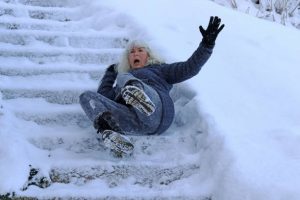
Winter brings to mind snow-blanketed lawns, fireplaces blazing, snowball fights, and hot cocoa. But, for some people, it summons up the image of dangerously snowy roads and icy sidewalks. Unfortunately, a slip and fall in winter weather can cause serious injury.
Common Winter Weather Injuries
The cold, snow, and ice make staying healthy and safe challenging. Emergency rooms see an increase in injuries this time of year, injuries that can often be prevented. The most common winter injuries are as follows:
- Slips and falls
Icy sidewalks, stairs and other surfaces are the main cause of slips and falls in the winter. As a result, injuries like broken bones, sprains and even head trauma send people to the emergency room. According to the CDC, slips on ice and snow account for a million injuries a year.Some of these injuries from falls can be prevented by taking simple precautions. Waddling like a penguin with short slow steps can decrease your chances of slipping. Additionally, plan to give yourself extra time to get to your destination and be aware while stepping out of a car. Make sure to get a solid footing and use both legs to step out.
- Neck and back injuries
Shoveling causes many cold weather sprains. Pushing the snow instead of lifting will help prevent injury. - Heart attacks
Shoveling is a strenuous activity, especially for people who do not regularly exercise. Avoid overexerting yourself and take frequent breaks. Better yet, have someone else do it for you! - Hypothermia
Hypothermia occurs when the body’s temperature drops below 95 degrees. Wearing layers of clothing will help in frigid weather. Signs of hypothermia include shivering, loss of dexterity, impaired thinking, high pulse and increased breathing. If any of these occur, seek medical attention. - Frostbite
Frostbite is permanent skin damage caused by extremely cold weather. Skin, nerves and tissue freeze at your extremities such as the hands, feet, ears and nose. Wearing gloves and dressing appropriately can help. - Carbon Monoxide poisoning
Carbon monoxide is called “the silent-killer” because it is an odorless, colorless gas found in exhaust fumes. Inhaling these fumes causes a build up in your bloodstream and decreases oxygen in your body. Symptoms of carbon monoxide poisoning include headache, nausea, dizziness and tiredness. The risk of injury or death increases during the winter months due to the use of fireplaces, furnaces and heaters.
Slip and Fall Accidents
Slips and falls are the most common winter weather injuries. As a result, accidents can result in high medical bills, lost wages, and a change in the quality of lifestyle, as well as possibly needing to rely on others to take care of you. Snow and ice removal laws require that a property owner clear the hazardous surface within a reasonable amount of time after a storm. Parking lots and sidewalks must be monitored for any freezing water, as well.
If you are injured as a result of a property owner not clearing their surfaces in the allotted time, you may sue for compensation. After a fall, it’s best to document the accident as soon as possible. Weather conditions can change quickly or the owner may clear a path so that others do not get injured, as well. Seek medical attention if needed. Take photos of the surrounding area and the hazardous conditions. If someone witnessed your fall, get their contact information. Proving that the owner was neglectful in clearing their sidewalks or parking lots is important for getting compensation in a lawsuit.
Contact an Attorney
When you are involved in a slip and fall that has seriously injured you or impacted your life, you will need an experienced lawyer. The Law Offices of Andrew Maze can assess your situation, provide the best legal options, and represent your interest.